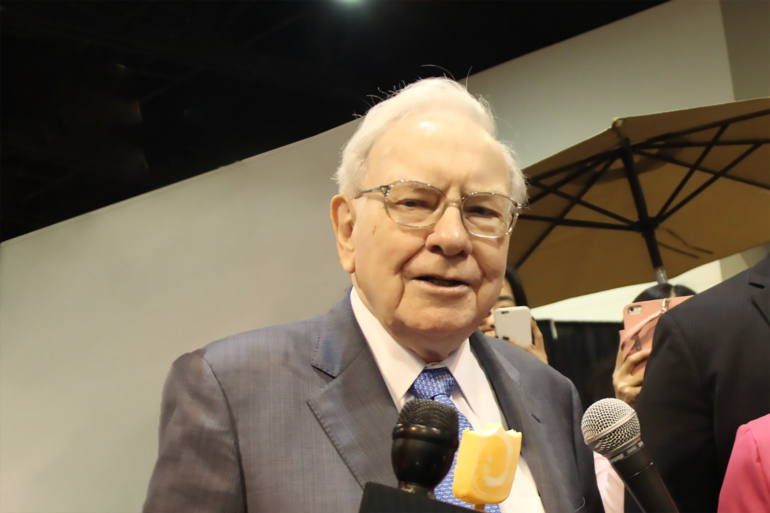To say that Warren Buffett is a great investor would be an understatement. A quick glance at his tremendous track record at the helm of Berkshire Hathaway (BRK.A -0.85%) (BRK.B -0.71%) would show this. But digging deeper, it’s clear that he is very fond of businesses in the financial services space. Berkshire‘s portfolio is chock full of these kinds of holdings.
Among the financial stocks Buffett and Berkshire favor, Visa (V -0.06%), Mastercard (MA 0.49%), and American Express (AXP -0.49%) really stand out. I think they’re three top Buffett stocks to buy hand over fist in the month of July.
Visa and Mastercard: thriving global card networks
Berkshire’s stake (as of July 13) in Visa totals roughly $2 billion. It’s the company’s 21st biggest holding and accounts for about 0.5% of Berkshire’s overall portfolio of stocks. Buffett and Berkshire own $1.6 billion worth of Mastercard stock, making it 0.4% of Berkshire’s portfolio. The two stocks together make up a relatively small fraction of Berkshire’s total holdings.
I’m discussing these companies together because they have similar business models and traits that make them incredibly attractive from an investment perspective. I’m sure Buffett noticed this as well.
Visa is a gargantuan card payments network with a presence in over 200 countries. Its cards are accepted by more than 100 million merchants and it has roughly 4.2 billion cards activated. Visa commands nearly two-thirds of the U.S. market, based on transaction volume.
With 26% of the U.S. market, Mastercard is in second place in the industry. It processed $8.2 trillion in transactions in 2022. And there are 3.2 billion cards on the Mastercard network.
The scale of each company’s operations results in massive two-sided network effects, giving it a duopoly position in the industry. The network effects also provide a powerful competitive advantage that makes Visa and Mastercard almost immune to disruptions from many smaller fintech businesses in the space. Their huge worldwide bases of cardholders mean that merchants almost have no choice but to accept Visa and Mastercard as payment options. And thanks to their wide acceptance, consumers want these types of cards in their wallets.
The nature of their businesses also means both companies generate outstanding profitability. Visa’s operating margin in fiscal 2022 (ended Sept. 30) was 64%, while Mastercard’s operating margin in its fiscal 2022 (ended Dec. 31) was 55%. It would be a struggle to find businesses that match these high levels. And their ability to generate free cash flow (FCF) is nothing short of spectacular. This is only possible because Visa and Mastercard have already invested in building out their respective networks, so there isn’t much need for ongoing capital expenditures. Both companies use FCF to pay small dividends, and they buy back sizable chunks of their stock.
Since its initial public offering (IPO) in 2008, Visa has been a wonderful investment to own. Its stock price has climbed 1,620%. Mastercard has fared even better, rising 8,640% since its IPO in 2006. These performances crush the S&P 500 index by a wide margin. Unsurprisingly, neither stock sells at an attractive valuation, but it might still be a good idea to follow in Buffett’s footsteps and add them to your long-term portfolio. They show every sign of continuing to outperform.
American Express
Compared to Visa and Mastercard, American Express is a much more significant holding for Buffett, as Berkshire owns 20% of its outstanding shares. It’s the third-largest position in the Berkshire portfolio.
Buffett is enamored of the stock, in part, because he likes the brand it has established for itself. He also likes the kinds of customers it attracts because they aspire to be associated with the brand. This is a big compliment in Buffett’s view, and it’s one of his criteria for investing.
Investors might assume that American Express operates a similar model to Visa and Mastercard, but this incorrect. Visa and Mastercard run open-loop networks where they partner with different financial entities that provide the actual credit (and take some of the reward as well as all of the risk) to the users making purchases. Visa and Mastercard earn a fee amounting to a small percentage of each transaction. American Express runs a closed-loop network. This means only its branded cards are processed on its payments platform and it provides the actual credit to the users.
Consequently, Amex not only makes money any time one of its 136 million cards is swiped at the point of sale, but it also earns a small percentage of the revenue from the millions of merchants that accept it as a form of payment, as well as interest from customers who don’t pay off their cards in a timely manner. American Express assumes the risk of credit default from customers, but it’s smaller than the average financial institution because its card customers tend to be more affluent and have better credit ratings. As a result, Amex’s loss rates are lower than other financial institutions.
American Express posted double-digit percentage revenue growth in 2022, and management expects revenue to increase 15% to 17% this year, with earnings per share rising 12% to 16%. At a trailing price-to-earnings ratio of 18.4, which is cheaper than its three-year average multiple, Amex looks like a good stock to buy right now.
This content was originally published here.



